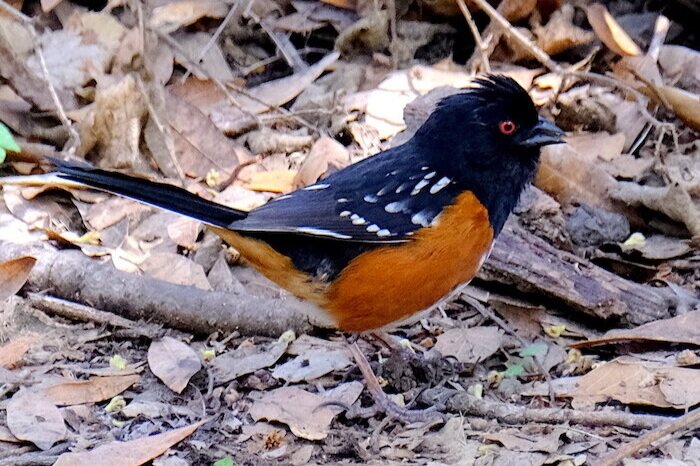Spotted Towhee
by Dave Zittin
The Latin binomial of the Spotted Towhee is Pipilo maculatus. Pipilo means chirp or twitter, and maculatus means stained or spotted. The spotted twitter-er, perhaps? I will leave that for you to determine after you listen to its song.
Male Spotted Towhee singing. Note the conspicuous red eye. Photo by Curt Bianchi.
This well camouflaged bird is hard to spot, but it often gives away its location by sound. The common song of our local Spotted Towhees is a buzzy, rapid trill that starts with a very short chirp. Both sexes have a cat-like meow call. Their distinctive sounds alert us to their nearby presence. I hear them most mornings in our neighborhood.
Like the California Towhee, the Spotted Towhee hops forward, then kicks both feet backward at the same time as they land, turning over leaves in search of food.
Attracting Spotted Towhees to Backyards
Spotted Towhees do not like being in open areas for more than a few seconds. In nature, they forage near or under brush. They eat off the ground. I have never seen one on my hanging feeders.
Male in typical feeding habitat. Photo by Dave Zittin.
Spotted Towhees are omnivores, but in breeding season, they tend to eat arthropods. In the winter, they increase their intake of plant material and consume more seeds and small fruits. I use a patio mix on the ground, which attracts a pair throughout the year. They seem to be intimidated by almost any other bird species, and often wait until the other ground feeding species have left before exploring for food. I have been placing some seed closer to shrubs in hopes that our Spotted Towhees feel more comfortable feeding there. We shall see.
Description
The Spotted Towhee is a large, long-tailed sparrow. The beautiful jet-black head of the male and the black upper parts spotted with white are distinct. These features plus chestnut flanks, the red eye and pure white belly make for an easy identification. The female tends to be a little paler than the male and has a dark gray-brown head and back colors.
Female. Note the brownish head. Also note the white under tail wedges and the white edge to outer tail feathers. Photo by Dave Zittin.
There are distinct white areas on the under surface of the tail near the distal end. These spots often show as white tail corners when viewed from above. Sometimes when I get a partial view of one flying away from me in thick brush, the black head and white tail flash reminds me of a Dark-eyed Junco.
Male showing white spotting on wings. Photo by Dave Zittin.
Juveniles show a lot of streaking and spotting and have reddish-brown color overall.
Distribution
Breeding populations occur over Western North America from Southern British Columbia and south into Mexico, but they avoid the driest areas in this range. Some breed as far east as Montana and the Western parts of North and South Dakota and migrate out of these areas in the winter. Spotted Towhees in our area are present throughout the year. If you are interested in knowing more about their complicated distribution, see the general information link below.
Similar Species
In Santa Clara County, no other bird species looks like the Spotted Towhee. We recently encountered a beginning birder explaining that she had seen both the adult and juvenile Spotted Towhee feeding in her yard. Juveniles are not often in the open, so with further questioning, one of us determined that she was calling Dark-eyed Juncos juvenile Spotted Towhees. To her credit, she recognized the similarities between these two local sparrow species, especially the black heads and some white on the tail feathers.
Juvenile Spotted Towhee by Deanne Tucker.
Explore
General information on the Spotted Towhee by All About Birds
The following recording is the typical song of our local Spotted Towhee subspecies. Listen carefully for a leading chirp sound followed by a rapid trill: Recorded by William R. Fish | Macaulay Library
This recording is a typical cat-like meow call: Recorded by Randolph Little | Macaulay Library
Spotted Towhee sounds from All About Birds
More Backyard Bird Information
View more common Santa Clara County Backyard Birds
Visit our Backyard Birding page
Read our Notes and Tips from a Backyard Birder series
Tell us what you’re seeing in your yard! Send your notes, photos, and sound clips to backyardbirds@scvas.org. We’ll feature your submittals on our website.
Banner Photo Credit: Spotted Towhee by Deanne Tucker






